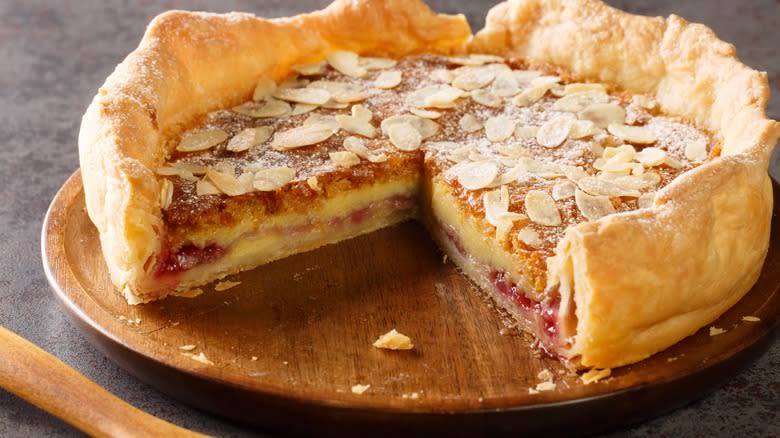The Difference Between A Bakewell Pudding Vs Bakewell Tarts

Bakewell tarts are an iconic British treat -- if you know, you know. But for those of you who don't, a Bakewell tart is a shortcrust pastry recognized for its half of a glacé cherry in the center of a white blanket of fondant -- it's pretty cute. Not to confuse the issue, but there is also an equally iconic treat known as Bakewell pudding. To Americans this becomes even more confusing, since what we think of as pudding and what the English call pudding are apples and oranges. For example, sticky toffee pudding would most certainly be considered a kind of cake in the U.S. The Bakewell pudding is more of a pastry than a tart, made with puff pastry instead of shortcrust, and has a thicker, custardy middle that gives it more of a traditional English pudding consistency.
Both the Bakewell tart and pudding have layers of jam as well as some iteration of almonds, so their biggest differences are in texture -- well, mostly. The Bakewell pudding is eggy; closer to something like a buttermilk pie. The Bakewell tart has a layer of frangipane -- not to be confused with marzipan -- giving it a spongier, almost pasty mouthfeel. Another difference between these two bakes is that the Bakewell pudding is often sweeter than the tart. This is probably mostly to do with the general sweetness of custard when compared to frangipane.
Read more: 8 Chocolate Bars That Are Totally Different Outside The US
History Of Bakewell

The history of the Bakewell pudding predates the Bakewell tart. The legend of the pudding says that the cook of a Derbyshire inn made it by accident in the mid-19th century. As the story goes, the cook misread the recipe for a jam tart left by the innkeeper, and instead of incorporating the eggs and almond paste into the crust, it was spread out with the jam as filling -- thus creating an English classic. There's no real evidence that this is what actually happened, but who doesn't love a haphazard origin story?
The Bakewell tart was created in the 20th century as a kind of modernization of the pudding. The tarts are sold in supermarkets and convenience stores all around the U.K., but diehard fans of the Bakewell tart will be the first to tell you that those aren't proper Bakewell tarts. The real tart was created in Bakewell, and unlike its pudding predecessor, it more closely resembles a traditional tart. It's usually made with strawberry or raspberry jam, topped with a layer of frangipane or almond meal, and is left un-iced.
English Pudding Vs American Pudding

The English use the word pudding to describe things that can be savory or sweet, so it gets a little tricky to know exactly what is implied when the word "pudding" is being used. In America, pudding is gloopy, sweet stuff. It's Jell-O pudding or a thick, sweet, custard -- there really isn't anything else it could be confused for stateside. For the English, the term pudding describes something more cake-like, or in the case of Bakewell pudding, a pie-adjacent dessert. Bakewell pudding can be most likened to a pie by American standards; however Americans and Brits can both agree that a Bakewell tart is, in fact, a tart.
The terms Bakewell pudding and Bakewell tart have been used interchangeably by people who simply don't know the difference, but they are definitely not the same thing. If you're looking for the authentic version of the tart or the pudding (maybe both) you can visit Derbyshire and the Old Bakewell Original Pudding Shop and taste the difference between these two treats for yourself.
Read the original article on Daily Meal.

